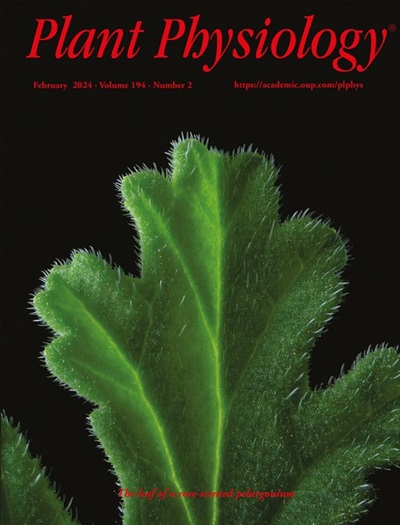病原体诱导肽 CEP14 可被受体样激酶 CEPR2 感知,从而促进拟南芥的系统抗病性。
IF 6.5
1区 生物学
Q1 PLANT SCIENCES
引用次数: 0
摘要
触发细胞信号转导的植物分泌肽对植物的生长、发育和对环境胁迫的适应性反应至关重要。在拟南芥(Arabidopsis thaliana)中,C-TERMINALLY ENCODED PEPTIDE(CEP)家族是一类分泌型信号肽,在系统发育上分为两组:第一组(CEP1-CEP12)和第二组(CEP13-CEP15)。第 I 组 CEP 肽调节根系结构和氮饥饿反应,而第 II 组 CEP 的生物活性和作用尚不清楚。在这里,我们报告了第二类 CEP 肽 CEP14 作为拟南芥免疫的病原体诱导激发物的功能。在拟南芥叶片和根部,CEP14 的表达通过水杨酸途径被高度诱导,以应对细菌病原体丁香假单胞菌的感染。在没有病原体侵袭的情况下,用合成的 CEP14 肽处理拟南芥植物足以触发免疫反应。遗传和生化分析表明,类似受体的激酶 CEP RECEPTOR 2(CEPR2)能感知 CEP14 以触发植物免疫。SOMATIC EMBRYOGENESIS RECEPTOR KINASES (SERKs) BRASSINOSTEROID INSENSITIVE 1-ASSOCIATED RECEPTOR KINASE 1 (BAK1) 和 SERK4 通过与 CEPR2 形成 CEP14 诱导的复合物,也参与了 CEP14 的感知。过表达 CEP14 在很大程度上增强了拟南芥对 P. syringae 的抗性,而 CEP14 或 CEPR2 突变则显著削弱了拟南芥对 P. syringae 的系统抗性。总之,我们的数据揭示了病原体诱导的 CEP14 肽可被 CEPR2-BAK1/SERK4 受体复合物感知,它可作为内源诱导剂促进拟南芥的系统抗病性。本文章由计算机程序翻译,如有差异,请以英文原文为准。
The pathogen-induced peptide CEP14 is perceived by the receptor-like kinase CEPR2 to promote systemic disease resistance in Arabidopsis.
Secreted plant peptides that trigger cellular signaling are crucial for plant growth, development, and adaptive responses to environmental stresses. In Arabidopsis (Arabidopsis thaliana), the C-TERMINALLY ENCODED PEPTIDE (CEP) family is a class of secreted signaling peptides that is phylogenetically divided into two groups: group I (CEP1-CEP12) and group II (CEP13-CEP15). Several group I CEP peptides regulate root architecture and nitrogen starvation responses, whereas the biological activity and roles of group II CEPs remain unknown. Here, we report that a group II CEP peptide, CEP14, functions as a pathogen-induced elicitor of Arabidopsis immunity. In response to infection by the bacterial pathogen Pseudomonas syringae, CEP14 expression was highly induced via the salicylic acid pathway in Arabidopsis leaves and roots. In the absence of pathogen attack, treatment of Arabidopsis plants with synthetic CEP14 peptides was sufficient to trigger immune responses. Genetic and biochemical analyses demonstrated that the receptor-like kinase CEP RECEPTOR 2 (CEPR2) perceives CEP14 to trigger plant immunity. The SOMATIC EMBRYOGENESIS RECEPTOR KINASES (SERKs) BRASSINOSTEROID INSENSITIVE 1-ASSOCIATED RECEPTOR KINASE 1 (BAK1) and SERK4 also participated in CEP14 perception by forming CEP14-induced complexes with CEPR2. Overexpression of CEP14 largely enhanced Arabidopsis resistance to P. syringae, while CEP14 or CEPR2 mutation significantly attenuated Arabidopsis systemic resistance to P. syringae. Taken together, our data reveal that the pathogen-induced CEP14 peptide, which is perceived by the CEPR2-BAK1/SERK4 receptor complexes, acts as an endogenous elicitor to promote systemic disease resistance in Arabidopsis.
求助全文
通过发布文献求助,成功后即可免费获取论文全文。
去求助
来源期刊

Plant Physiology
生物-植物科学
CiteScore
12.20
自引率
5.40%
发文量
535
审稿时长
2.3 months
期刊介绍:
Plant Physiology® is a distinguished and highly respected journal with a rich history dating back to its establishment in 1926. It stands as a leading international publication in the field of plant biology, covering a comprehensive range of topics from the molecular and structural aspects of plant life to systems biology and ecophysiology. Recognized as the most highly cited journal in plant sciences, Plant Physiology® is a testament to its commitment to excellence and the dissemination of groundbreaking research.
As the official publication of the American Society of Plant Biologists, Plant Physiology® upholds rigorous peer-review standards, ensuring that the scientific community receives the highest quality research. The journal releases 12 issues annually, providing a steady stream of new findings and insights to its readership.
 求助内容:
求助内容: 应助结果提醒方式:
应助结果提醒方式:


